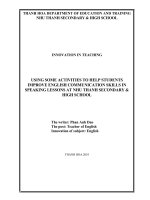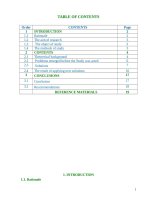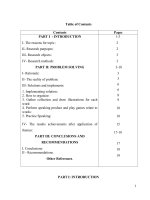skkn cấp tỉnh using games to teach speaking skill effectively for grade 10 students at ba thuoc secondary and high school
Bạn đang xem bản rút gọn của tài liệu. Xem và tải ngay bản đầy đủ của tài liệu tại đây (479.41 KB, 28 trang )
<span class="text_page_counter">Trang 1</span><div class="page_container" data-page="1">
<b>BA THUOC SECONDARY & HIGH SCHOOL </b>
INNOVATIVE EXPERIENCE
<b>USING GAMES TO TEACH SPEAKING SKILL EFFECTIVELY FOR GRADE 10 STUDENTS </b>
<b>AT BA THUOC SECONDARY & HIGH SCHOOL </b>
<b> Written by: Bui Thi Hang Career: Teacher </b>
<b> Field of the innovative experirence: English </b>
THANH HOA 2024
<small>TABLE OF CONTENTS</small>
</div><span class="text_page_counter">Trang 2</span><div class="page_container" data-page="2"><b>PART 1: INTRODUCTION</b>
5. New Points and Benefits Bringing Innovations Page 4
<b>PART 2: CONTENT</b>
Chapter 2: STATEMENT OF RESEARCH PROBLEM Page 7
1. Solutions to Improve the Students’ Speaking Skill through games Page 8<small>1.1</small> Solution 1: Suggestions on using games Page 8b/ 1.2 Solution 2: Using some Typical Games Page 10
2.Practical Application of the Solutions for students 10<small>th</small> grade at BaThuoc Secondary & High School
Page 12Chapter 4: EFFECTIVENESS OF THE TEACHING EXPERIENCE Page 18
<b>PART 3: CONCLUSION AND RECOMMENDATIONS</b>
b) For the Department of Education and Training Page 21
GCSE= General Certificate of Secondary Education MOET= the Ministry of Education and Traininge.g. = example
</div><span class="text_page_counter">Trang 3</span><div class="page_container" data-page="3"><b>PART 1: INTRODUCTION1. The Reasons for Topic</b>
We can see that English is a compulsory subject in the national curriculum aswell as in the GCSE exams in our country. Students have to learn English fromgrade 3 until grade 12. But only reading, writing skills and grammar are tested inthe national exams. So listening and speaking are not really paid much attentionby the teachers and the students. The problem we have to face is how to raisestudents’ awareness of speaking skill and make speaking lessons moreinteresting so that they will learn it better. In the international relationship,English speaking ability is very important to be able to participate in the wider
</div><span class="text_page_counter">Trang 4</span><div class="page_container" data-page="4">world of work. The speaking skill is measured in terms of the ability to carry outa conversation in the language. This really makes teachers and parents think thatspeaking ability should be mastered by their students and children. Basing onthe fact, I focused on doing research on methods to teach and learn speakingskill that will help students improve their speaking skill and help my teachercolleagues have more practice teaching methods in speaking classes.
My school uses the new national English syllabus for high schools by theMinistry of Education and Training (MOET) named Tieng Anh for Grade 10students. It aims at helping students to achieve pre- intermediate communicativecompetence. In this school year, the textbooks, Tieng Anh 10 (new), 11 and 12all consist of 10 units. For every unit of English lesson, four language skills suchas reading, listening, speaking and writing as well as language (vocabulary andgrammar), communication and culture and project are included and taught in 8periods. The speaking lessons are also theme-based and task-based. However, asa matter of fact is that tests of all levels at secondary schools are almost inwritten forms. Although speaking skill accounts for 20% of the test at the end ofeach term, there is no period given for students to do the speaking tasks duringthe term. So the teachers often use time in different lessons to consolidate toevaluate students’ speaking skill.
Knowing the drawbacks of teaching and learning English at the current time, Ihave done research to find out solutions to improve the students’ speaking skillthrough games. However, before applying the solutions, I looked more closely atconveniences and obstacles for the implementation of games in teachingEnglish.
</div><span class="text_page_counter">Trang 5</span><div class="page_container" data-page="5">+ The interaction between students and teachers when using active methods inthe teaching process often flashes the students with wonderful ideas.
+ The input quality of English of Ba Thuoc Secondary & High School is low,but in recent years it has been improved.
<i><b>I still expect to promote potential students’ capacity through my study: “Using</b></i>
<i><b>games to teach speaking skill effectively”.</b></i>
<b>2. The Aims of the Study</b>
Many have been said about the weaknesses of the traditional English teachingmethod in Vietnam, and the strengths of the communicative language teachingapproach. However, the general situation of Vietnam’s English teaching andlearning at present is not very satisfactory, as “dumb English” is still stubbornlyrooted in a large number of English learners. So it is safe to say that there is stilla long way to go in English teaching reform and improving the English teachingquality of Vietnam. Sometimes it is easy to get a new method like thecommunicative language teaching approach heard but difficult to get it accepted,understood and applied to practical classroom teaching in the end. Therefore, itis not out of date to discuss the techniques of applying the communicativelanguage teaching approach to classroom teaching. In this document, on thebasis of pointing out the disadvantages of the traditional teaching method, Idiscuss and explore one way to teach students effectively – using games inteaching English speaking skill, which is often considered as one of the best way
</div><span class="text_page_counter">Trang 6</span><div class="page_container" data-page="6">to get the students involved in the classroom activities in which theircommunicative ability is practised and improved. Language games, as one of themost valuable and effective techniques in English language teaching, have beenused for a long time by many western teachers. However, they are less used inVietnam, especially in High School English Teaching classrooms. Most teachersand students think games are a waste of time or just a fun activity for students.In this article, I propose to talk about the importance of using games in EnglishTeaching and list eight types of games to practise students' speaking. Finally,some considerations are put forward on using games and the success of usinggames is stated.
<b>5. New Points and Benefits Bringing Innovations</b>
- These suggestions focus on explaining how to design activities for somespeaking tasks in the textbook to facilitate teaching speaking skill to students atlow level basing on the theory of adaptation and principles as well as approachesof teaching speaking.
- The measures have been applied in teaching and preparation for the tests andexams at Ba Thuoc Secondary & High School over the past two years. Theymay be useful reference materials for students as well as colleagues in teachingand learning in new ways.
<b>PART 2: CONTENTChapter 1: RATIONALE</b>
There are many good ideas about English teaching. Among these, using gamesin the English class is the one which is most easily accepted by students andwhich is also a very useful and helpful aspect of communicative method. Asknown to everyone, game is an activity providing entertainment or amusement;
</div><span class="text_page_counter">Trang 7</span><div class="page_container" data-page="7">it is a competitive activity or sport in which players contend with each otheraccording to a set of rules. “A game is an activity carried out by co-operating orcompeting decision-makers, seeking to achieve, within a set of rules, theirobjectives”. A game is an activity that both the teacher and students enjoy doing.It is student-centered and as appealing as playing in the playground.
Using games in English class can get students relaxed and enjoying using thelanguage. It may be argued that college students, unlike children, having grownup, do not need games to relax themselves. On the contrary, adults sometimesfeel more nervous than children when they face new things, and they are moreafraid of losing their face as the sense of face develops with their age. In thissense, they do need games or any other activity that help them relaxed andinnocent like children to the new language without being afraid of makingmistakes. According Stephen Krashen (1982), second language acquisition isinfluenced by affective factors either positively or negatively. One of theteacher’s tasks is to create a situation where students’ affective filter is loweredso that the comprehensible input could be taken in. The first aim of using gamesin class is just to create such a situation.
Games are communicative in essence, and so using game in English teachingand learning can well realize the fundamental idea of the communicativelanguage teaching approach. Using games is a good way to improve students'various skills, as Wright, Betteridge and Buckby (2006) say, "Games can befound to give practice in all the skills, in all the stages of the teaching andlearning and for many types of communication". In playing language games,students have to know and well understand the rules of the games, and should beclear about what has been, is being and will be done or said, and what is moreimportant, they have to take some actions – doing or saying something, tocompete in the games. In so doing, they can practise their skills of listening,speaking, reading and writing comprehensively, and especially they get morepractice in listening and speaking, which are poor in the traditional teachingmethod. Professor Littlewood proposed that through games, teachers should
</div><span class="text_page_counter">Trang 8</span><div class="page_container" data-page="8">help learners go beyond the mastery of structures, to the point where they canuse them to communicate meaning in real situations.
Game playing is effective in developing students’ communicative ability in thatit is a dynamic process of communication in which students as thinking beings,emotional beings and communicators instead of knowledge receptacles, try toget their ideas, concepts, thoughts, emotions and feelings expressed, based ontheir own life experiences. Psychologist Piaget proposes that movementproduces “thought”. He believes that movement is the beginning of learning,and that cognitive frame is built up step by step whose joint is the movement butnot the consciousness.
In addition, games may help and encourage many learners to support theirinterest and work. Games can increase motivation to learn the language asstudents, especially the weaker ones, feel a real sense of achievement when theymanipulate a game. Games can provide quite extensive knowledge input. Gamescan increase students' communication and co-operation with each other. Andgames can act as a testing mechanism through which they will expose areas ofweakness and the need for remedial work.
Furthermore, games can be used at any stage in a lesson: at the beginning todiagnose what the students can or cannot do; during the lesson for languagepractice purposes; or at the end as reinforcement and reward. Students playinglanguage games are encouraged to express their ideas for certain purpose, andthey can use different types of games at different stages appropriate for differenttypes of language learning.
<b>Chapter 2: STATEMENT OF RESEARCH PROBLEM</b>
For years, the main method of teaching English in Vietnam is like this: firstly,the teacher explains the new words in the vocabulary list by giving definitionsand examples. Then he/she will give a brief introduction to the background ofthe task. When dealing with the task, the teacher always explains and translatesit sentence by sentence or even word by word, sometimes with a few questionswhich seldom elicit answers or responses from students. Finally, a reciting task
</div><span class="text_page_counter">Trang 9</span><div class="page_container" data-page="9">or translation exercise is given to the students. In short, the traditional way ofEnglish teaching is teacher-centered and language-knowledge-focused. The wayof teaching English is similar to that of teaching mathematics: new wordspresented, related grammar explained, and then written exercises assigned; ifstudents can do the exercises well, it means that they have learned the languageknowledge well, and then the lesson moves on. Under such pattern of teaching,students are passive information receiver and written exercises doer. They canremember large numbers of words and grammatical rules, and they can do verywell in exams, but they scarcely have chances to express themselves in the targetlanguage and test their understanding of the received information about thelanguage. And they are found having a lot of difficulties in communicating withothers in English. This phenomenon is ironically defined as “Dumb English”,which is the “product” of long hard work of both teachers and students.
As you know, our students have learnt English at primary and secondaryschools. However, English is still the most difficult compulsory subject for themas it is a foreign language. Besides, they are not good at English so many ofthem find studying this subject difficult. The reason for this is that they comefrom low- income families in a rural area and do not have the chance to useEnglish outside classrooms. Their parents are mainly farmers who cannot helpthem at all in studying English and they do not have enough money to supporttheir children to learn English in extra classes in Foreign Language Centres. Asa result of this, these students have no motivation and encouragement, no goodconditions to study and they do not find English useful and important. They arenot well supported in their study. This means that their levels and motivation tolearn English are rather low.
Actually, most students have no good conditions to study, so English learning isstill limited. And students rarely get access to good studying orientation,especially to learning English skills. For the past few years, the school'senrollment scores have been very low as it is a rural school. In fact, no one inmy school has ever got mark 10 in English subject in the GCSE exams. The
</div><span class="text_page_counter">Trang 10</span><div class="page_container" data-page="10">number of students getting marks from 2 to 4 has accounted for the largeproportion in some recent school years. From years, I am in charge of teachingEnglish for grade 10, 11 and 12 students. I know my students’ difficulties whenstudying English. In other words, I want to help the students achieve the goalthat they set in their lives. During the time of teaching English, I have realizedthat it is significant to change my methods of teaching and my students’ viewabout learning speaking skill through useful games.
<b>Chapter 3. THE PROBLEM SOLUTIONS</b>
<i><b>1. Solutions to Improve the Students’ Speaking Skill through games</b></i>
<b>1.1. Solution 1: Suggestions on using games</b>
There are four elements which should be taken into consideration when playinggames in English class. Teachers should keep them in mind and apply the abovediscussed games to the practical situation appropriately in order to achieve thebest results.
<b>1.1.1. Time </b>
The amount of teaching time devoted to games depends on the individualteaching content, but it will probably be a relatively small proportion of the totalteaching time. They can be used to open or close a lesson in a stimulation way,to punctuate a lesson, to relieve tension after a test or concentrated practicesession, or at any time that the teacher feels appropriate. It is important that theyare used positively, to give students enjoyment and useful practice.
<b>1.1.2. Choice </b>
In each category of game mentioned above, there are different kinds of games.So the teacher must take many factors into account when deciding which gamewould be most appropriate and most successful with his or her students at anytime. He or she should consider the level of the students, the main aim of havinga game, the interest of the students, the appropriate time to use a game and theavailability of aids and materials.
<b>1.1.3. Preparation </b>
</div><span class="text_page_counter">Trang 11</span><div class="page_container" data-page="11">Games may be good fun but they need to be carefully prepared and organized.Firstly, the teacher should find a good game in a book or invent one. Then he orshe must be sure that the necessary facilities are available. An overheadprojector can be very useful if one is available. If not, a typewriter and cards andthe objects needed should be prepared in advance. Also, the teacher shouldensure clear handwriting on paper or cards so that the students will take theteacher's intentions seriously. Finally, the teacher must work out how the gameis to proceed, what the students will need to do and how they will be instructedin what to do. It is important to try to anticipate any logistic or linguisticproblems that may occur in order to be able to deal with them effectively.
<b>1.1.4. Management </b>
The teacher must decide in advance how to organize the students and theclassroom so that the setting up of a game can be carried out as quickly andsmoothly as possible. It is advisable to encourage pair and group work wherepossible, as this will increase student participation and the amount of languagepractice offered to each student will be much greater. While the students areworking, it is useful for the teacher to keep a close eye on pairs or groups tohelp, correct or stimulate less active students. The teacher should stop a gameand change to something else before the students become tired of it. In this way,their willingness and concentration are retained.
<b>1.2. Solution 2: Using some Typical Games </b>
As stated above, the main purpose of using games in English classes, especiallyin speaking sections, is to practise students' different skills, especially theircommunicative ability. Here, eight types of games from published sources(Carrier 1980, Ellis 1986, Harmer 1985, Kallsen 1982, Klippel 1984, MaCallum1980, Porter-Ladousse 1987, Stern 2002, Willis 1982, etc.) are identified,discussed and explored.
<b>1.2.1. Guessing Games </b>
The basic role of guessing games is very simple: one person knows somethingthat another one wants to find out. The thing to be guessed can differ greatly
</div><span class="text_page_counter">Trang 12</span><div class="page_container" data-page="12">from game to game. It can be a word, an object, an activity or many other things.Guessing games are useful in helping students practise logical thinking andasking questions.
<b>1.2.2. Picture Games </b>
Picture games include several types: Comparing and contrasting pictures;Considering differences or similarities; Considering possible relationshipsbetween pictures, such as narrative sequence; Describing key features so thatsomeone else may identify them or represent them in a similar way; Making astory according to the given picture.
Most of these picture games involve the learners in the relatively free use of allthe language at their command and at the same time give them the opportunityto practise their speaking and listening.
<b>1.2.3. Sound Games </b>
Sound effects can create in the listeners’ mind an impression of people, placesand actions. There is a demand for the listener to contribute through theimagination. This inevitably leads to individual interpretations which mean thatthe listeners can exchange their points of view and express opinions and ideas.This kind of games can stimulate students' imagination and thinking, and offerthem a chance to practise their listening and speaking. Students can make guessat the object described by sound, or make dialogue or a story.
<b>1.2.4. Mime </b>
Mimes can be done in pairs, groups or even by the whole class. One side has toperform the mimes for the other side so that the answer can be found. It can bean object, action or person. So miming activities are valuable language-learningsituations. Guessing something is linked with the real desire to find out and thusis a true communication situation. Miming trains the students' skill ofobservation and improvisation. It emphasizes the importance of gesture andfacial expression in communication.
<b>1.2.5. Fact-finding Games </b>
</div><span class="text_page_counter">Trang 13</span><div class="page_container" data-page="13">This mainly deals with general knowledge and is a very practical exercise.Every day, there is something important happening, so the students can be askedwhat happened on a day in history. It may be a historical accident, a birthday ofa famous person, or something strange or marvelous. Then further details can beasked. The students can discuss in pairs or groups in order to find much moreinformation.
<b>1.2.6. Debates </b>
In this activity, a topic is given and two sides are set up, one supporting the ideaand the other opposing it. Then they argue giving their evidence. The aim of thisactivity is to get the students to talk and stimulate their interest and competitivespirit. Such activities make the students think about their values and priorities.There is no doubt that this activity will improve students’ conversation andeloquence.
Class Debates are the best alternative methods to improve students’ speakingskill when they do not have enough time to do all of the tasks in the speakingsections in their textbooks.
Each and every student possesses his or her own opinion. Classroom debatesenable students to voice their opinions. A debate provides the students with anopportunity to conduct themselves in a professional manner. According to theInternational Debate Education Association, “Debate is, above all, a way forthose who hold opposing views to discuss controversial issues withoutdescending to insult, emotional appeals or personal bias. A key trademark ofdebate is that it rarely ends in agreement, but rather allows for a robust analysisof the question at hand.” The whole class can play some games in the classroomleading up to the debate, and allow the competing teams to play against eachother building a productive rivalry through words.
<b>1.2.7. Jigsaw Games </b>
Each participant in a jigsaw task holds one part of a solution, which may be astory, a factual text or a picture. They are equally important. They should worktogether to fit their pieces together to find the solution. They, therefore, improve
</div><span class="text_page_counter">Trang 14</span><div class="page_container" data-page="14">co-operation and mutual acceptance within the group. Participants in this gamehave to do a lot of talking before they are able to fit the pieces together in theright way. Wright (2006) also claims that these games practise two verydifferent areas of skill in the foreign language: “Firstly, the students have tounderstand the bits of information they are given and describe them to the rest ofthe group.” This helps them realize the importance of pronunciation andintonation in making oneself understood. “Secondly, the students have toorganize the process of finding the solution and a lot of interactional language isneeded.”
<b>1.2.8. Role Plays </b>
Role plays often consist of short scenes, which can be realistic or pure fantasy.Role plays may be enacted around everyday situations as well as around topicalproblems. One easily-obtained role play is from the text, which may be actualrole play material. After learning the text, students can be asked to give aperformance of it. This can improve their oral performance generally and, ofcourse, help students to understand what they have learned in an easy way.Furthermore, role plays are useful for generating free expression and the feelingof spontaneity in the language classroom.
<b>Secondary & High School.</b>
The study involved over 40 students from 10<small>th</small> grade at Ba Thuoc Secondary &High School, Thanh Hoa province. Those students took part in the study duringspeaking sections in the school year 2023- 2024.
<b>GAME: Guess the words</b>
The teacher gives instructions:
to the picture.
</div>








